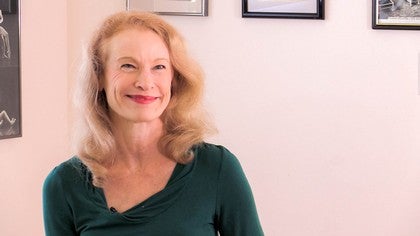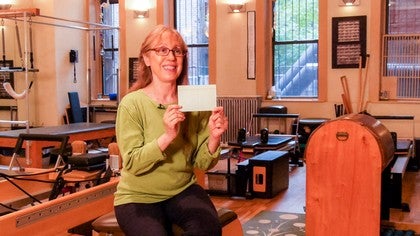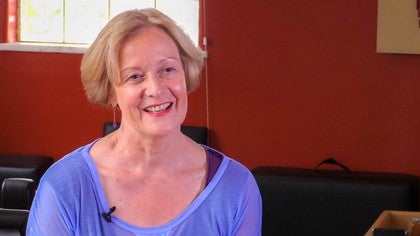Description
About This Video
Transcript
Read Full Transcript
Hi, I'm Jillian Hasso and we're here in Beverly hills in my tiny little studio. And I want to talk today about how I found Corolla tree or one of my favorite mentors. And I believe it was 1981, maybe 1980. I don't, I'm not sure. Um, I had been working with Kathy grant for a number of months and my unemployment insurance as a dancer ran out. So I didn't have a job as a dancer. And Kathy said, well, you know, my studio is too small to hire teachers, but I know somebody who might need you. She's just called me and said she needs an extra teacher, so why don't you go over to Corolla and interview with her? And the funny thing about Manhattan, for those of you who don't know Manhattan is it's so small and compact.
So we're talking about West 57th street between sixth and fifth and sixth avenue was where Henri Bendel's department store was Kathy's studio. And Corolla was on West 58th street off of seventh avenue. So literally it's a couple of crosstown blocks in one uptown block. It was a stone's throw. So Cathy didn't really prepare me much for Corolla, but I set up the interview and walked into this studio.
It was quite different from Kathy's, Kathy's being upstairs in Henri Bendel's. Uh, you went up and elevate her through the store. Kay Corolla actually had a home studio, much like my own. So you would arrive, uh, downstairs and there was a doormen who had to let you in and then, uh, take you upstairs to her studio. And it was her front door as well cause she lived there and I believe she had perhaps two apartments, maybe just a larger apartment that had been kind of subdivided to her living quarters in her studio. But in any case, I rang the bell and this diminutive, tiny little silver haired lady answered the door with her hair all perfectly quaffed and she was wearing a black leotard and beige tights and little gymnastics shoes. And that was Corolla. So she did an interview with me, which was quite something.
I walked into her studio and all of the equipment was aqua blue, aqua blue, and um, kind of scary looking. But I'd seen it before at Kathy's. Hers was Brown though. So this was quite a change to see it in aqua blue and a much bigger studio. Um, she had three reformers, two Cadillacs, a raised mat, an armchair, and a high, uh, highchair. She had no ladder bureau, but she had the, um, the smaller step peril and a and wonderful pictures, anatomy and, uh, a couple of lounge chairs as well, which I'll get to later. And she sat me down and said, so why do you want to work for me? And, um, what are you interested in?
And talk to me a little bit. And uh, meanwhile I was watching everybody in the studio and it was quite a different energy from Kathy's. What was interesting about Carola's was she had, I believe herself and two teachers at any given time on the floor and clients did not do warm ups the way they did at Cathy's. They started right away on the reformer. However, with that said, Corolla always did the first session herself and it was a posture analysis. So she would roll out. She had this great mirror that was two sided on wheels and it was a Corolla was a, a showman or a show lady, I should say.
She always had sort of ceremony, um, with everything that she did and it was a gift. She, she really made you feel special. So she would roll out this mirror on wheels and do her posture analysis where you were confronting your body in a vertical alignment and checking everything out and evaluating your posture. And then you went and sat on the reformer leaning over like so and she would check your breathing and that was really, really important. And then right away from there, she put you into footwork on the reformers. So everyone at her studio went through about a 25 minute workout on the reformer. Then they would move to the Cadillac for about 20 minutes.
It was like a circuit. And then they would do the arm chair and she had a high wound, a chair. It wasn't a wound, a chair, it was the high chair, the electric chair. We call sometimes a and then they were out of there except that they were required to rest. So they, she had these lounge chairs that you would sit back in and lean back and your legs would go up in the air. And if you were a first time client, she would have taken you through the whole routine. So she would give you her scrapbook with all of her press clippings, which I can show you later and you would have a little bit of the history of plots. But also what Corolla has placed in that history was she had a lot of press and that's how her studio works.
So people moved through very, very quickly. And when she interviewed me to see if I would be suitable candidate for her to train as a teacher, uh, she said to me very clearly now, Jillian, I want you to know that as a politeness teacher you can make a nice living, but you'll be rich. Never be rich. And it's hard, hard work. But it's very rewarding. The very first day that I was coming to work for Corolla. My shift was from 8:00 AM to 1:00 PM and I remember I was very nervous.
I lived way downtown. I took the subway up and I was early and I stood outside on the street and then in front of her door looking at my watch, thinking, well, she lives there. I don't want to get there too early and intrude on her time. At least she had told us all very clearly before she opened, which was at 8:00 AM that she did her own workout and I didn't want to intrude on that, so I decided I didn't really know what to do, but I waited until 8:00 AM on the nose because I didn't want to intrude on her personal time knowing that was her home and so I rang the bell and she came to the door and dressed me down. You can't get here at eight o'clock if you have to be on the floor at 8:00 AM I want you here and ready to answer the door at eight you should be the one answering the door, not me. Well after that I was never late again, but she's scared the living daylights out of me. She was adamant, but she hadn't specified what time I was supposed to get there.
So I was guessing. The irony was I was waiting killing time, but she wanted me, they are ready to greet the first client. We never, you never walked in the door was locked. You rang the bell. Someone had to answer it in a meet you Kathy new Corolla because Cathy had worked for Corolla tree air previously before she opened the Bendel studio, she trained with Joe and then worked for Karola alongside of Lolita San Miguel. So I believe that Kathy went to Karola because of Romano, who also knew Corolla. They were all tight, like little sardines. So, uh, Kathy knew about Corolla and they exchanged, I think a lot. Corolla, one of the first people she would call if she needed a new teacher was Kathy. And that's how I got there. And what I wanted to say is once a Correla had interviewed me and ascertained that I might be a good candidate, she told me again, I could make a good living, but I wouldn't become wealthy. But it was hard work, but very satisfying. And then she said, now the first thing is if you are going to work for me, you need to know what it's like to be a student first and how I treat my students. So I was immediately calmed with 10 free classes.
She had little lockers because again, she had quite wealthy ladies who came with all their jewelry and she didn't want any jewelry worn. It's so different now in California, we wear our hair loose. We were all our jewelry and Corolla was extremely strict. The hair had to be tied back. It wasn't good enough to be in a ponytail. I was allowed to teach wearing a ponytail. But if I had long hair, it had to be in a bun because the hair could get into the, um, springs and into the, uh, wheels wrapped around and her reformers, it did not come off the, the, um, the tracks. It was, uh, it had, uh, a pole right down the middle and it rode along the pole, which kept it very stable, but you couldn't remove it to clean it very easily. Leotard and tights for all the ladies. She had a, a mixture again, just like Kathy of, uh, these ladies who lunch, we would call it the ladies of leisure businessman who came completely dressed in tie jacket, the, the whole, the whole deal.
They would shower before they left. She had full showers. And, um, then she had all of the dancers, both, uh, dancers and training from the School of American ballet and a lot of New York City ballet professionals, which was really exciting for me coming from the ballet world. Um, at one point I was training Gelsey Kirkland, which was pretty exciting. I worked simultaneously with both Kathy grant and Corolla. Um, what was wonderful for me because my, uh, period is an unemployed dancer continued after Corolla hired me, was that I would go to Corolla in the morning. I had a shift from 8:00 AM in the morning til 1:00 PM, and that was where I was learning to teach. And then I would go to Cathy in the afternoon for my personal workouts. So for the good part of a year, I worked with both women simultaneously.
And it was quite interesting because I would get to Kathy's and she said, well, now what are they doing over there? Or things were so brusque and quick with Corolla, moving people through kind of the same routine. She would specialize with people who had problems of course, but there was a pretty set routine for the general fit public at Carola's, which was very different from Cathy's. And we had to keep moving them through because she was busy. So, um, I would take my questions often to Kathy and say, I don't understand. She's doing this this way and you do it that way.
And what's the difference and why? And Kathy love to hear what Corolla was doing because I was the next generation. Um, and everyone evolves in their teaching and change is so Corolla might not have been doing it exactly the same when Kathy worked for her as when I was working. But Kathy was so busy, she didn't have time to go to Corolla. So I was kind of the go-between and it was great for me because gorilla was very brusque, very German.
I wonder how much her studio might've been a like with Joe's, with that, keep moving. Don't talk, just do it. And, uh, Kathy was a little bit a quieter and, but, but took the time to explain the way people compare. Joe Polonius to Clara polities I think maybe Corolla was a bit of Joe and Kathy was a bit more let Clara, this style of Corolla was quite different from Kathy, although you could tell they were the same exercises. But I had the first inkling that Kathy had really individualized my warm up and my exercises for specific reasons because she knew about my curvature of the spine. She knew that I had come to her with, uh, with the scoliosis and Sciatica pain going down one leg. So my first inkling that things were really different was on the reformer. And I remember I was winging with Carrie Roland who was one of her great male teachers and he was tapping my butt and going, you're not using your buttocks, what's going on? You're not come on, what's happening? Wake up. And um, I didn't understand because Kathy's emphasis at the time since I had Sciatica was not to have me clenching the Piriformis, the gluteus t to aggravate.
And My abdominals were in a weakened state, uh, despite all my dancing. And so Kathy's first order of business with me was to teach me spinal articulation and stabilization and level my hips and she concentrated on the core muscles and the abdominals. She didn't worry about my buttocks so much. I was a dancer and I was turning out and uh, working them. But I didn't use them as much as Corolla would have liked. And for a healthy client I wasn't using them.
So that was kind of a big wake up call. But mostly I remember at Carola's, it was so fast that I felt like I had lived in Europe for four years and studied both French and become quite fluent and German. But when you're learning to grasp a new language, after a day of that or hours of that, you leave thinking your head is stuffed with cotton wool and you can't quite pull out things in the correct order. And I felt very much like that at Carola's because I didn't know the routines and I didn't know the protocols and the sequencing. And she was very strict. She was German. It was very ordered and it had to be a certain way.
And not only were you learning exercises, and of course inside I was doing my best to translate the exercises to my specific problems that I had learned how to address things to Cathy. I was also having to learn the reformer setups and the springs and the straps and the long spinal straps, the short spinal straps, first, second, third gear, how many springs, uh, safety issues, which were numerous. Uh, I really was hard pressed to learn it all quickly. Corolla was extremely strict. A lot of people would've said she was a drill sergeant. Uh, she also was a good 10 years older than Kathy. I believe. Kathy was probably in her mid to late fifties when I met her.
But Corolla was in her mid to late sixties. She was a good 10 years older. We remember Corolla was the first teacher that Joe ever trained who opened a studio with his blessing. He built, uh, or supervise the building of all of her equipment. So, uh, she was already having heart trouble. And our rule of thumb among all the teachers was don't get Corolla too agitated cause she's highly agitated. And um, if she did, she'd run off and open a drawer and start popping nitric gristle glycerin pills and we were all nervous that she was going to have a heart attack on our watch. So we kind of wanted to keep things smooth, but much like Kathy, you just wanted to watch and learn and uh, not disappointed. Corolla would get progressively more agitated if there was too much discussion in the studio. She didn't like a lot of talk.
She didn't like exercise breakdowns or explanations. She wanted people to move. And so she would say too much talk, too much talk. Um, I always say about Corolla. She was the original person who came up with soundbites. Now maybe Joe had them too. Maybe Clara had them, but she had these soundbites and you were allowed to learn those and use those. So for instance, we use today so much navel to spine, but one of Carola's favorites was, uh, she called it the straight stretch on the reformer, the plank position.
But we call it the long stretch today. She would say from the head to the, here, you're a piece of steel in her German accent. Maybe that was Joe, I don't know. But we were allowed to use those soundbites, but we weren't allowed to go into detailed explanations. It was kind of like getting people to do the exercises would train their bodies. There were certain exercises that clients were not allowed to do on their own. We were very much more than at Cathy's where it was. Take your notes, learn your routine itself. Service. We were into service at Corollas.
Corolla charged more than Joe did and I think she probably charged more than uh, Kathy as well. Although she had a dancer rate always that was a discount. But, uh, we were fetching and carrying long spinal straps, short spinal straps, changing gears, changing springs. People did not have to memorize their routines at Corollas. The way that, uh, we did at Kathy's, that was quite different. And certain exercises, as I said, we're not done at all in less. They were assisted, for example, Jackknife and she had three different versions of Jack Knife. Everyone did a jack knife, but there were very different versions and they were always hands on guided. Uh, you waited until a teacher was available to do Jack Knife. You didn't do it on your own ever. The assists were very, very specific and it's something that I've attempted to keep in my teacher training, not just how the client executes the exercise, but Corolla was extremely specific in training me as a teacher in all of us on where to stand so that you didn't hurt your back or strain your body because you're doing this for hours a day, assisting client after client, how to hold the clients so that they felt safe and secure because doing an exercise like backstroke, swimming our boxes were tiny little things and she would put these big man on them and you had to know how to spot those exercises to make the client feel secure that they weren't going to fall off.
So we were drilled not only on the soundbites and the exercise cues, but where to stand, how to touch. We are not to touch of course, what part of the hand to use, whether to use the hand to stimulate a muscle or guide. Uh, there was a certain rhythm to the speech pattern when Corolla would teach. She used her voice almost like music, inhale and exhale. And it was a very much a whole body approach and uh, we were drilled on all of that. There was a very specific way that she wanted her clients handled so that they felt taken care of. When I began, I was paid $4 an hour and the top teacher made 10 and so I had a ways to go to grow and of course the dollar went further in those days. But my job at the very beginning, because I had no previous training except what I had done with Kathy and the 10 sessions with Corolla was to set towels out on the reformers before the client arrived to set up the springs before the client began their footwork.
Usually it was three or four springs, again, only four springs on a reformer. And I was allowed to hold the feet during footwork. That was about it. And then I, at the end of the day, if I worked in afternoon shift, I took formula four oh nine and went around and sprayed and cleaned all of the finger marks that had accumulated during the day. I was gorilla was fanatic about cleaning as was Cathy, but gorilla being German. It was really specific. And so I watched and learned mostly I had to ask for another teacher or a, whenever there was anything hands on guided to begin with.
And then Corolla watched me and would critique my form over and over again until I got it the way she wanted it. She was not going to let me work with clients until she was sure. I know, knew what I was doing. Karate, I didn't talk too much about Joseph Politesse. She had his anatomical body charts, uh, where he's leaning over and lifting you. I'm sure you've seen those. Uh, she had so much press of her own. She had done a whole series of articles for dance magazine. She worked with, um, two different orthopedic doctors.
Uh, I think it was a Dr. Henry Jordan, and then, um, William Leibler, two orthopedic surgeons from the Lenox Hill Hospital. And she had actually, uh, attended surgeries where she saw the knee opened up. Uh, she was invited and she worked hand in hand with a lot of rehabilitative, um, uh, clients. And she had one client, Mrs Talaska, who was probably in her sixties, probably the same age as Corolla, who had had polio as a child. And she, she walked on those polio crutches with a brace on her leg and Carlos worked her out, but she had a very specific program, uh, working with just only one leg on the, uh, reformer and Corolla did a lot of special work with not only the dancers but, uh, injuries. And she really knew anatomy. She was a certified massage therapist as well as having been, of course, a professional dancer, Acrobat rollerskating. Contortionist uh, she was pretty remarkable. So she had a whole run of clients. We would get young dancers from the School of American ballet who were referred because they had a certain weakness and the they, they needed body conditioning.
But Corolla didn't talk much about Joe. Uh, I remember Kathy always saying, the man said, the man said, but Corolla, I don't remember her talking much about it, about Joe. I was with Karola at a very interesting time in her life. She wrote the book exercise, was it what it is, what it does, which is a tremendous children's book. They were doing a series of drugs, what they are, what they do, alcohol, what it is, what it does. And mostly it was all these negative things. And the one positive was Corolla exercise, what it is, what it does and why. And the thing that was terrific about that was she was so specific and anal about it being perfect and atomically perfect.
She had Dr. William Leibler looking at the illustrations to make sure they were anatomically correct and she loved cats. So she decided she was going to have a little cat in there. And the cat, if you look at the book, is a little easel and he's pointing up things and kind of, he's always there doing the exercises kind of in the background. And it was such a charming book and so positive and I think the experience for her was great. So then she decided after that success that she was going to write her memoirs and she started doing that and I would come in and she would be a wreck in the morning. She was reliving a lot of her, uh, time in Europe during the Nazis in World War Two. And, um, building up to World War II and losing friends and family. And she could not talk about it. She, like a lot of survivors, just, it was shut the door and she dropped the project. She couldn't, she couldn't do it. But there were many times I'd come in the morning and say, how are you? And she'd say, well, I had an angina and I thought I was going to die.
So I got up and I was doing the payroll because I don't want to go to the hospital or die. And not have you guys paid. She had to take care of us even in her angina moments. But yeah, she would've been doing payroll in the middle of the night with her angina. She was like that just, and then one of the things I thought was so charming, also having lived in Europe myself and being spoiled as a performing artist in Europe, I had a year round job, paid vacations, cost of living, increase Christmas, bonus retirement, all of that. And My dance career there for four years, we had um, at least four weeks, sometimes six paid vacations. So Corolla was very European and she never stayed open in August.
So in July you would be coming in and she'd say, well now let's book, she'd have her book fresh and she wanted to book your first September appointment, but she was closed for an entire month and she would go back to Europe and visit with her friends there. And everyone just made their first appointment in September and came back. Can you imagine today closing down for an entire month and having your clients come back? I have to say that my time with Corolla was either in the studio where it was business and I was learning how to teach velocities or she would take me back behind the scenes to her kitchen and sit me down and say, now, what's going on with you? Because at the time that I was working for Corolla, my mother was dying, she was mortally ill and it was a very tough time for me. Corolla became my grandmother and she really nurtured me.
She'd scream at me in the studio to the point where I was going to cry and then she'd take me back and she was my grandmother and we did talk shop. We didn't talk shop. I learned when we were, but there was I think because she lived in her studio and there's so many times because in my life I've lived in my workspace so much that Corolla was a role model for me to separate work from personal and have that dividing line and be able to turn it off sometimes. Corolla was an amazing business woman at a time when there weren't many women in business, and this is preceding my time with her. She had a business in the 1950s when most women wear 'em Ozzie and Harriet housewife type and her husband was an accountant and he kind of helped her set up everything, but she had her whole, her whole bookkeeping system and everything was just so from the moment you walked in and had your first session with her and everything was very positive and upbeat, you felt supported as a client and she told you her whole history after you had done your first session and you laid in the chair, she would give you her scrapbook and you would buy a series and usually it was a series of 10 or I don't know if she had series of twenties I think most people were on series of 10 and of course there were no computers. So she had her little file box and she had you in the morning, you would pull out the cards of the people coming and set the cards to the left of the people who are on a series in the cards to the right of somebody who, as she said, started new. And if you came in and you were starting new, which meant your series was running out, she would say, you start new next time, little reminder.
And hopefully they would have cash or a check or they would come in next time with a cash or a check, having been reminded. But it was, she, she, I remember her telling me they start new next time. It's not that it's their last lesson and that whole psychology, she just had an intuitive grasp of how to please the client. Everything was spic and span clean. Everybody had their towel, which they moved with them from the reformer to the Cadillac, always using that. If it was a big man, she'd have a big, uh, a big bath towel if they were sweating, you know, something to, uh, keep them comfortable. And then there was the routines, um, to check the toilet paper. If the role was starting to run out the, the paper towel, the toilet paper, she didn't like it if it was getting empty and that had to be taken off and a new one put on the soap. She bought her soap special in boxes from [inaudible] admins, which is now defunct, but it was a very fancy department store and she got this beautiful sentence soap. And if it got too small, she saw those big men in the shower. Let's throw it away and put a new one. And this is the best story.
Her Springs, she changed her springs. I don't remember how often they were. There was a lot of traffic. So she was always, she taught us how to check them to see if they were worn out. And one specific thing that I find very different about how we work today, we're so worried about safety and so was Corolla, but the springs were just with a hook. There was no, um, a little clip on the end. So we would run our fingers through the, the, the actual hook to make sure there was no wear and tear and if it was at all worn, the springs were thrown away.
But she would throw her springs away anyway just as a matter of course every few months. And the teachers would all go in the trash and take them out and take them home and attach them to the door and use them because they weren't necessarily worn out. But she just didn't like anything to have a used look. I think it's from coming from a lot of hardship from uh, growing up in Europe and, and during the war, but also she had very high standards and she didn't want anything to look cheap or used or skimpy. She also made European coffee on there. I forget her watching, watching her make coffee cause she made coffee for me sometimes and it was the kind that the spoon would stand up and she would take a big Mug, put one of those Melita filters that sits over the top, take four heaping scoops of espresso type coffee and pour only half full in the, in the mug. So she was wired. I knew when I had her coffee that I was going to be really like this, you know, for the day it was, it was a little scary during the time that I worked for Corolla, my mother died.
I had said she nurtured me through that and it was a very, very difficult time for me. But subsequently I had a friend in Miami, Florida who invited me down. And by the way, while I was down there, it was a modern dancer. She had me. Um, she had set up an audition for me with a local modern dance company in Miami and I was offered a job immediately with them. And knowing I had a job back in New York with Corolla and that I couldn't leave her in the lurch. I said, I would love to come, but I can't come right away. My mother's just passed away and I have a job and I can't leave right away, but I'd like to come later in the year. So I returned to New York and at the time I was studying simultaneously with Cathy grant at the Graham school and working for Corolla and at the Graham school was a wonderful dancer named Deborah Lesson A. I thought, wow, she's such a good mover. And so I approached Deborah and I said, you know, I have this wonderful job at Corolla treaters studio. And she said, oh, I took some lessons there. I think she had been there in the past, but dropped it. And I said, well, I have a job to move to Florida and I need to bring in somebody to replace me.
And would you be interested? So she did and the rest is history to ever took my job and I moved to Florida to dance. And um, so that's how Deborah got to grow all of the second time around and became a teacher. I came out to California after that and I started my own business after working at the Fletcher Studio. And, um, Corolla really became my mentor. Going back to your question about how did she teach me to run a business? Well now I was running my own studio and it was in my home much as she had started her business and she really became a big role model for me that time.
Uh, I used to call her with all kinds of questions and she would give me advice and going back to how she separated her, uh, her private life from her business life. At one point I remember her yelling at me because something had happened in the current events of the world and I didn't know what she was talking about. And she said, well, you know, sometimes you just have to read a newspaper, Jillian, you know, get real, get out of the pilates world for a moment and be a person. And she kind of helped me with that. She did. But whenever I'm cleaning, I think of her actually.
And whenever I'm telling a client they start new next time I think of her, I want people to know about Corolla, that she was really a groundbreaker, not only as the first person to open a studio after Joe's original body control ology studio, but not only that, that she was a woman, that she was a survivor from the Nazis, that she was a Jew, and, uh, that she worked with these doctors. And, uh, really we think about now how we interface in our industry with physical therapists, how many physical therapists have become [inaudible] teachers and how that males, and she was the first. So, uh, she really broke the ground for us. And I don't think she's as known and she deserves to be.
Pilates Legacy Project: Discussions
Comments

It would be great to have you come to Switzerland.
We would love to have you come and share more and teach.
You were so fortunate to be taught and experience time with Carola and Kathy. Deborah Lessen also shared much when she came to Switzerland in 2012. Again, thank you for sharing such wonderful history.
You need to be a subscriber to post a comment.
Please Log In or Create an Account to start your free trial.




























